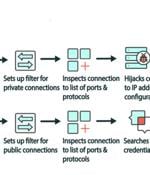Security News

A malware botnet named 'Pumpkin Eclipse' performed a mysterious destructive event in 2023 that destroyed 600,000 office/home office internet routers offline, disrupting customers' internet access. The incident had a focused impact, affecting a single internet service provider and three models of routers used by the firm: the ActionTec T3200s, ActionTec T3260s, and Sagemcom F5380.

A malware botnet named 'Pumpkin Eclipse' performed a mysterious destructive event in 2023 that destroyed 600,000 office/home office internet routers offline, disrupting customers' internet access. The incident had a focused impact, affecting a single internet service provider and three models of routers used by the firm: the ActionTec T3200s, ActionTec T3260s, and Sagemcom F5380.

A maximum-severity security flaw has been disclosed in the TP-Link Archer C5400X gaming router that could lead to remote code execution on susceptible devices by sending specially crafted...

The TP-Link Archer C5400X gaming router is vulnerable to security flaws that could enable an unauthenticated, remote attacker to execute commands on the device. The TP-Link Archer C5400X is a high-end tri-band gaming router designed to provide robust performance and advanced features for gaming and other demanding applications, and based on the number of user reviews the product has on online stores, it appears to be a popular choice among gamers.

Using a VPN through a router remains a more clever and comfortable way to ensure that every device in your home or office is secured, including those that originally didn't support a VPN network. VPN router works by channeling all your home devices' connections to a secure VPN server, thereby reducing the need for individual or manual connections.

The U.S. Cybersecurity and Infrastructure Security Agency (CISA) on Thursday added two security flaws impacting D-Link routers to its Known Exploited Vulnerabilities (KEV) catalog, based on...

The D-Link EXO AX4800 router is vulnerable to remote unauthenticated command execution that could lead to complete device takeovers by attackers with access to the HNAP port. The D-Link DIR-X4860 router is a high-performance Wi-Fi 6 router capable of speeds of up to 4800 Mbps and advanced features like OFDMA, MU-MIMO, and BSS Coloring that enhance efficiency and reduce interference.

Cuttlefish, a new malware family that targets enterprise-grade small office/home office routers, is used by criminals to steal account credentials / secrets for AWS, CloudFlare, Docker, BitBucket, Alibaba Cloud and other cloud-based services. "With the stolen key material, the actor not only retrieves cloud resources associated with the targeted entity but gains a foothold into that cloud ecosystem," Black Lotus Labs researchers noted.

A never-before-seen botnet called Goldoon has been observed targeting D-Link routers with a nearly decade-old critical security flaw with the goal of using the compromised devices for further...

A new malware called Cuttlefish is targeting small office and home office (SOHO) routers with the goal of stealthily monitoring all traffic through the devices and gather authentication data from...